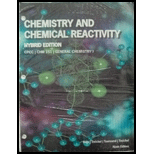
(a)
Interpretation: The overall equation has to be given.
Concept introduction:
Molecularity: Elementary steps of a
Rate equations for elementary steps: The rate equation for elementary step is defined by its reaction stoichiometry.
(a)
Answer to Problem 2CYU
The overall reaction is:
Explanation of Solution
The overall reaction is given as,
The overall reaction is:
(b)
Interpretation: The rate determining step has to be given.
Concept introduction:
The
The raise in molar concentration of product of a reaction per unit time or decrease in molarity of reactant per unit time is called rate of reaction and is expressed in units of
The variation in concentration of reaction or product over a certain interval of time is called average reaction rate.
The equation that relates the reaction rate to the reactants concentrations that is raised to various powers is called as rate law.
Rate law can be determined by the slow step or otherwise called as rate-determining step.
(b)
Answer to Problem 2CYU
Step 2 is the rate determining step.
Explanation of Solution
The overall reaction is given as,
The rate determining step:
The rate of overall reaction is controlled by the slowest step in the mechanism. So, the step 2 is the slowest step which determines the rate of overall reaction.
(c)
Interpretation: The rate equation for the rate determining step has to be given.
Concept introduction:
The rate of reaction is the quantity of formation of product or the quantity of reactant used per unit time. The rate of reaction doesn’t depend on the sum of amount of reaction mixture used.
The raise in molar concentration of product of a reaction per unit time or decrease in molarity of reactant per unit time is called rate of reaction and is expressed in units of
The variation in concentration of reaction or product over a certain interval of time is called average reaction rate.
The equation that relates the reaction rate to the reactants concentrations that is raised to various powers is called as rate law.
Rate law can be determined by the slow step or otherwise called as rate-determining step.
(c)
Explanation of Solution
Rate equation for rate-determining step:
The overall reaction is given as,
The rate determining step:
The rate of overall reaction is controlled by the slowest step in the mechanism. So, the step 2 is the slowest step which determines the rate of overall reaction.
The rate equation for the rate determining step is
(d)
Interpretation: The reaction intermediates has to be given.
(d)
Answer to Problem 2CYU
The reaction intermediates are
Explanation of Solution
Intermediates are the molecules that are formed from the reactants and reacts to give the products in a chemical reaction. Hence, the two molecules that are generated in between the reaction and get turned to products are
Want to see more full solutions like this?
Chapter 14 Solutions
CHEMISTRY+CHEM...HYBRID ED.(LL)>CUSTOM<
- The thermal decomposition reaction of N2O5(g) is investigated and the following rate constants are measured: a) Calculate A and Ea values of the Arrhenius Equation.b) Find the ΔH#, ΔS# and ΔG# values of this reaction.All the work must be hand written and explained with sufficient details.arrow_forwardIn a hypothetical reaction of 2B + C ➡ D, the order of reaction for the given equation is??arrow_forwardThe rate constant of a hypothetical reaction at a fixed temperature is 21.3 dm6 mol-2 s-1. how to deduce the overall order of reaction? A.0 B.1 C.2 D.3 E.Cannot be deduced Please answer with explainarrow_forward
- The rate equation for a reaction: A → B is r=K[A]0 . If the initial concentration of the reactant is a moldm-3 , the half-life period of the reaction is?arrow_forwardWhat is the half-life for a reaction with a rate constant k of 0.0045s-1arrow_forwardwhat is the order of reaction with respect to A and the rate constant of the reactionarrow_forward
- There are three potential termination steps in this mechanism. Confused on how to write two of them, using fishhook arrows to show how the electrons move. And how to have a valid termination step involves the combination of any two radicals involved in the propagation part of the reaction mechanism.arrow_forwardCan you propose a way by which the rate of reaction may be quantitatively measured?arrow_forwardWhich of the following reactions occurs by a one-step mechanism as opposed to a two-step mechanism?arrow_forward
 Chemistry: Principles and ReactionsChemistryISBN:9781305079373Author:William L. Masterton, Cecile N. HurleyPublisher:Cengage Learning
Chemistry: Principles and ReactionsChemistryISBN:9781305079373Author:William L. Masterton, Cecile N. HurleyPublisher:Cengage Learning Chemistry: Principles and PracticeChemistryISBN:9780534420123Author:Daniel L. Reger, Scott R. Goode, David W. Ball, Edward MercerPublisher:Cengage Learning
Chemistry: Principles and PracticeChemistryISBN:9780534420123Author:Daniel L. Reger, Scott R. Goode, David W. Ball, Edward MercerPublisher:Cengage Learning


